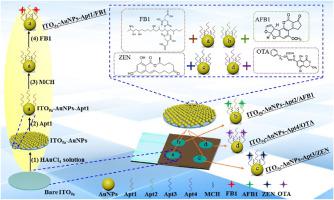Analytica Chimica Acta ( IF 5.7 ) Pub Date : 2023-10-16 , DOI: 10.1016/j.aca.2023.341921
Jing Qian 1 , Yue Liu 1 , Haining Cui 1 , Huiyuan Yang 1 , Mustafa Hussain 1 , Kun Wang 1 , Jie Wei 1 , Lingliang Long 1 , Lijun Ding 1 , Chengquan Wang 2

|
Background
Coexisting multiple mycotoxins in food poses severe health risks on humans due to the augmented toxicity. Current multiplex detection methods for mycotoxins have evolved from instrumental analyses to rapid methods based on the specific recognition of antibody/aptamer using different signal transducers. However, nearly all of the reported aptasensors for multiple mycotoxins detection require external labels and can only simultaneous detection of two mycotoxins due to the limitation of distinguishable labels. The tedious labeling process definitely increases the operation complexity and the detection cost. Therefore, rapid method for simultaneous label-free detection of multiple mycotoxins in cereals is urgently needed.
Results
A disposable aptasensing chip was designed for simultaneous label-free detection of fumonisin B1 (FB1), aflatoxin B1 (AFB1), zearalenone (ZEN), and ochratoxin A (OTA) in one sample. Specifically, ITO conductive glass was divided into a rectangle (35 × 25 mm) and then etched by laser to set aside the required four ITO working electrodes (6 mm in diameter) with respective conductive channels. Gold nanoparticles were electrodeposited on the working electrodes to provide abundant anchoring sites for thiolated aptamers immobilization. On this basis, a disposable aptasensing chip for simultaneous label-free detection of four common coexisting mycotoxins has been developed, which used electrochemical impedance spectroscopy as transducer to measure direct biorecognition of the aptamer and corresponding target. This aptasensing chip provided wide linear ranges of 5–1000, 10–250, 10–1250, 10–1500 ng/mL for FB1, AFB1, ZEN, OTA, respectively, with the respective detection limit of 2.47, 3.19, 5.38, 4.87 ng/mL (S/N = 3).
Significance and novelty
This aptasensing chip shows fantastic characteristics of great simplicity and portability, easy operation, and multiple mycotoxins recognition. They are easy to produce on a large scale at low cost and the design concept can be easily expanded to screen a large panel of coexisting targets. This work provides a new avenue for multi-target detection and represents a substantial advance toward food quality and safety monitoring or other fields.

































 京公网安备 11010802027423号
京公网安备 11010802027423号